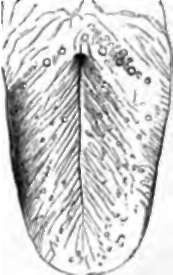165. Taste
Description
This section is from the book "Animal Physiology: The Structure And Functions Of The Human Body", by John Cleland. Also available from Amazon: Animal Physiology, the Structure and Functions of the Human Body.
165. Taste
Taste is a sense which is closely allied to both common sensation and smell, and as it is less definite in its nature than the other special senses, so also it is dependent on a less definitely distinguished nervous supply; for while smell, sight, and hearing, have each a special nerve devoted to them, the organ of taste has its sensory supply from two mixed nerves, the glosse-pharyngeal and the gustatory or lingual branch of the fifth.
The organ of taste is the upper surface of the tongue. This is covered with papillae, which differ from those on the general surface of the skin, not only in being larger, but also in being compound. The papillae are of three kinds. Thickly disposed over the whole surface are those of smallest size, the filiform kind, which are long and slender prominences, as their name indicates, and have a few simple papillae at their extremities. Scattered sparsely among the filiform are the fungiform papillae, which have a rounded shape, and sometimes remain red when the rest of the tongue is furred, giving a spotted appearance to the surface. The papilla? of the third description are called circumvallate, and are several times larger than the fungiform. They are usually less than a dozen in number, and are arranged near the back of the tongue in two lines diverging from the mesial groove in a curved fashion. They, as well as the fungiform kind, have simple papilla? on their broad tops, and they get their name from each being sunk into a hollow, whose outer wall rises up like a rampart to a level with it.

Fig. 111. Tongue, showing the circumvallate papillae near the root, and the fungiform scattered over the surface.
The epithelium which covers the tongue is of a thick stratified squamous description; and the variations in the distinctness of the papillae, in different states of health, depend more on the condition of the epithelium than on differences in the prominences which they clothe.
Continue to:
